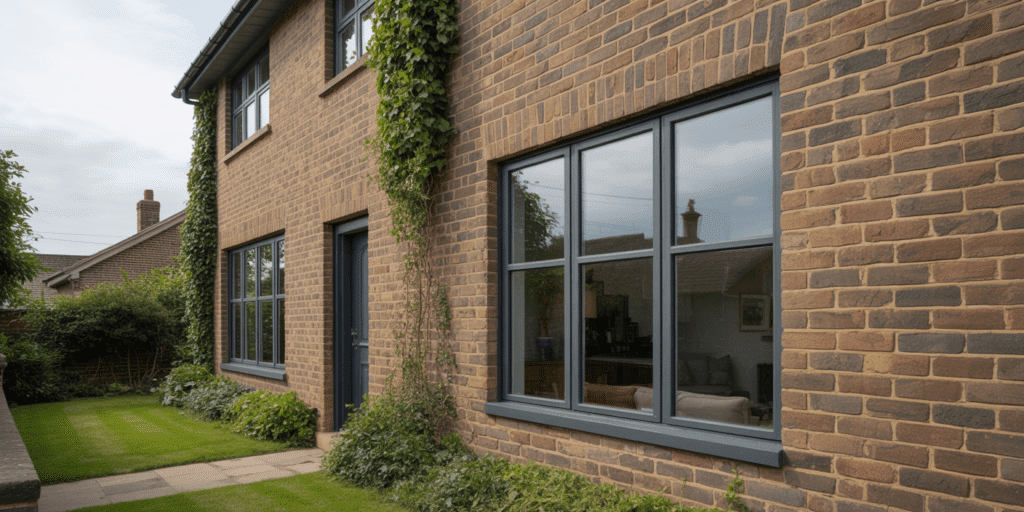The Silent Problem in Luxury Homes
How traditional windows undermine modern performance—without a visible trace.
In some of London’s most prestigious residences—Georgian townhouses, Victorian villas, and converted heritage flats—comfort is being quietly compromised.
At first glance, these properties exude refinement: soaring ceilings, intricate plasterwork, original timber sashes. Yet behind this architectural elegance lies a systemic inefficiency. Outdated glazing and uninsulated frames are allowing significant heat loss, driving up energy consumption and silently pushing properties out of regulatory compliance.
This is not merely an aesthetic issue, nor a matter of personal comfort. Under the UK’s evolving regulatory framework, particularly with the tightening of Part L and SAP assessments, substandard window performance directly affects EPC ratings, long-term marketability, and the viability of development or renovation plans. For many, the problem is only discovered during a failed audit, a compliance check, or a sale negotiation.
Sash Windows London has long recognised this structural gap between period form and contemporary function. Their technical expertise lies in bridging that divide—designing and delivering heritage-accurate sash windows that meet or exceed modern thermal performance expectations.
Through precision engineering and deep regulatory fluency, they have demonstrated that it is entirely possible for a listed or conservation-area property to achieve exceptional energy efficiency—without compromising appearance, planning integrity, or resale value.
What Is Passive House, Really?
It’s not about hugging trees. It’s about engineering that works.
There’s a dangerous misconception in the world of high-end property: that Passive House means futuristic architecture, German minimalism, or environmental overkill. It doesn’t. It means precision. It means comfort. It means silence, stability, and long-term certainty—especially where your windows are concerned.
Passive House (or Passivhaus, to use its original German) is a rigorous international building standard. Its aim is simple: reduce energy use so effectively that a home barely needs traditional heating. It’s not a style or aesthetic. It’s a performance guarantee. Every material, detail, and connection point must contribute to extreme energy efficiency and airtightness.
For windows, that translates into one unambiguous demand: U-values must be exceptionally low—typically 0.8 W/m²K or better. That’s not marketing fluff. It’s a quantifiable threshold that determines whether a window retains heat like insulation… or leaks energy like a punctured tyre.
But here’s the crux: Passive House doesn’t mean your home has to look modern. It doesn’t require solar panels or flat-roof minimalism. In fact, companies like Sash Windows London have proven that you can meet Passive-level performance using heritage-style sash windows—with all the sightlines, mouldings, and details required by planning authorities in conservation areas.
Passive House is the standard that bridges old and new. It tells you whether your home is quietly performing or slowly failing. And it begins with the part of your building most exposed to the elements—and most misunderstood by homeowners: the windows.
The U-Value: A Number That Changes Everything

It’s not a marketing term. It’s a scientific verdict on whether your windows are helping you—or robbing you.
U-values are the unsung rulers of your home’s comfort, efficiency, and compliance. Most homeowners have heard the term. Very few understand just how much it governs—until a failed EPC, a skyrocketing heating bill, or a planning snag brings it to the surface.
So what exactly is a U-value? In simple terms:
It measures how much heat energy escapes through a material. The lower the U-value, the better the insulation. Windows with poor U-values leak warmth every minute of every winter. Those with excellent U-values act like transparent insulation, holding onto heat while letting in light.
Here’s the science:
U-value is measured in watts per square metre per degree Kelvin (W/m²K). In practice, it calculates how many watts of heat are lost per square metre of window for every degree of temperature difference between inside and out.
Now, let’s talk numbers:
| Window Type | Approximate U-Value (W/m²K) |
| Single glazing (old sash) | 4.8–5.5 |
| Double glazing (basic) | 1.6–2.0 |
| Modern triple glazing | 0.8–1.2 |
| Passive House certified window | ≤ 0.8 |
Here’s what’s often missed: the U-value of a window isn’t just the glass.
It includes the entire unit—glass, frame, spacers, gas fills, edge seals, and installation. That’s why buying based on centre-pane values alone is misleading. A cheap double-glazed unit might advertise 1.2, but its whole-unit U-value could be much worse once fitted—if it’s even tested.
This is where Sash Windows London distinguishes itself. Every window is engineered and tested as a complete thermal system—not just a pane of glass in a frame. From warm-edge spacers to thermally broken timber-aluminium hybrids, each component is selected to lower the whole-unit U-value without compromising the traditional look that planning officers (and homeowners) demand.
And in a Passive House—or any property aspiring to its level—there’s no room for error. Because U-value isn’t just a number—it’s your compliance, your comfort, and your long-term energy strategy.
The Passive House Window Standard (And Why Most Fail It)
To meet Passive House, your windows must act like insulation—without looking like it.
Passive House doesn’t make suggestions. It sets thresholds. When it comes to windows, the standard is clear: if your whole-unit U-value exceeds 0.8 W/m²K, you’ve failed the test. No guesswork. No exemptions. No marketing spin.
This isn’t an arbitrary figure plucked from thin air—it’s grounded in thermodynamic modelling, building envelope physics, and over 30 years of real-world data from homes that maintain year-round thermal comfort with barely any active heating.
The problem? Most windows sold to British homeowners—yes, even premium ones—don’t get close.
Let’s look at why:
❌ The Glazing Gap
Basic double glazing rarely dips below 1.6 W/m²K. That’s twice the permissible limit for Passive House. And centre-pane values—often used in sales brochures—are meaningless if the edge seals and frames leak heat like sieves.
❌ Cold Frames
Even the most efficient glass can be undermined by a frame with poor thermal breaks. uPVC warps. Aluminium transmits cold like a radiator. And many timber frames are uninsulated, making the window behave more like a hole than a barrier.
❌ Flawed Installation
A Passive-grade window installed with traditional methods can underperform by up to 50%. That’s right—installation is just as critical as design. Airtightness, reveal sealing, and perimeter insulation all contribute to the final thermal performance.
Now compare that to what Passive House–compliant windows require:
| Component | Passive House Requirement |
| Whole-unit U-value | ≤ 0.80 W/m²K (frame + glass + spacer) |
| Glazing | Triple, low-E, argon/krypton gas-filled |
| Frames | Thermally broken timber, aluclad, or composite |
| Spacers | Warm edge (no conductive metals) |
| Installation | Airtight, thermally continuous, vapour-controlled |
And here’s the part most overlooked: none of this means you have to live in a glass box. Passive House–compliant windows can now be built to replicate heritage sash styles, Georgian bars, and even meet planning conditions in conservation areas—if you know where to look.
Sash Windows London has spent years engineering windows that blend invisible performance with visible tradition. They offer slim-profile triple glazing, thermally broken hardwood-aluminium hybrids, and detail-perfect joinery that passes the Passive House test without betraying the period character.
So while other suppliers debate aesthetics versus efficiency, they’ve quietly solved both.
Sash Windows London: When Performance Wears a Heritage Face
You don’t have to choose between tradition and transformation.
For years, luxury homeowners, architects, and developers have faced the same dilemma: how do you upgrade thermal performance without compromising heritage aesthetics?
Most window suppliers offer a false choice—performance or beauty. They show you thick-framed triple glazing that looks like it belongs on a suburban development, not a Regency townhouse. They warn you that listed buildings “can’t be improved.” They assume conservation rules mean compliance is off the table.
Sash Windows London disagreed. And then they did something about it.
Their approach wasn’t to chase gimmicks or bolt modern parts onto old frames. It was to rethink the window from the inside out—and re-engineer it to Passive House standards without changing its face.
Traditional on the Outside
Every window is handcrafted with period detailing so precise, it satisfies both planning officers and preservation purists:
- Authentic sash horn profiles
- Slim sightlines and putty-line glazing bars
- Hand-finished timber, matched to original mouldings
- Conservation-ready proportions
They look, feel, and even sound like they belong on a heritage street in Chelsea, Mayfair, or Hampstead.
Engineered on the Inside
But inside the frame, the story changes. These windows hide:
- Triple-glazed units with ultra-low-E coatings and argon or krypton gas
- Warm-edge spacers that eliminate thermal bridging
- Thermally broken frame cores, combining hardwood and internal insulation layers
- Aluminium-clad timber options (aluclad) for lifetime durability with zero maintenance
Every detail is calculated. Every seal, joint, and junction is tested for airtightness. The result is a heritage-style sash window that achieves whole-unit U-values below 0.8 W/m²K—quietly satisfying Passive House targets while maintaining period authenticity.
Installed Like Precision Joinery
The transformation doesn’t stop at the product. Sash Windows London employs specialist fitters trained in airtight installation. That means:
- Vapour-controlling membranes
- Thermal continuity at reveals
- Seals that don’t degrade over time
The performance promise doesn’t stop at the factory. It’s delivered in your walls.
This is where most suppliers fall short. They sell a product. Sash Windows London delivers a system, a process, and a compliant result—designed for discerning clients who want elegance, efficiency, and regulatory confidence in one perfect frame.
What Low U-Value Windows Buy You (That You Can’t See)

It’s not just what you see out of your windows. It’s what you no longer feel.
A beautiful home shouldn’t require a fleece in winter. Nor should you hear the neighbour’s motorcycle every morning at 6 a.m. or feel a cold draft coiling around your ankles when you walk past the sitting room bay.
These small discomforts—so often dismissed as quirks of “older houses”—are signs of energy loss. Of poorly performing glazing. Of U-values that don’t match the elegance of the postcode.
When Sash Windows London installs ultra-low U-value windows, the results go far beyond a better EPC rating. They reshape how a home feels. And more importantly, how it functions.
Silence You Didn’t Know Was Missing
Triple glazing, warm-edge spacers, and airtight frames do more than retain heat—they block noise. Once fitted, clients frequently report the same thing: “It’s like someone turned the city off.”
- Less traffic noise
- No wind whistles through gaps
- No rattles, no creaks
- Just silence and stillness
In a luxury home, peace is non-negotiable. And it begins at the window.
Consistent Warmth, Corner to Corner
With Passive-level U-values (≤ 0.8 W/m²K), heat no longer escapes through the glass. That means:
- No more cold zones near windows
- No condensation on panes
- No temperature drops from room to room
Radiators cycle less. Thermostats hold steady. The home remains visibly unchanged, but feels fundamentally different.
Energy Bills You’ll Actually Notice
Lower U-values aren’t just a compliance tick. They have direct, compounding financial returns:
- Reduced reliance on heating
- Smaller, more efficient boilers
- Improved SAP scores and EPC ratings
- Greater appeal on resale due to running cost transparency
Many of Sash Windows London’s clients find that comfort improves instantly, but the real value emerges on the second or third energy bill.
Future-Proof Compliance. Today.
With building regulations tightening (Part L, Part Q, Part F), and the energy market in flux, homeowners face two choices:
- Retrofit reactively, expensively, and late
- Act now with a compliant, aesthetic-first solution
Choosing windows that meet or exceed Passive House U-value standards isn’t overkill. It’s insurance—against regulatory shocks, rising bills, and future disruption.
In short: low U-value windows don’t just let in the light. They protect everything else.
The Hidden Variable: Why Installation Makes or Breaks U-Value
A Passive-certified window installed poorly is no longer a Passive window.
Most suppliers stop at the frame. They deliver the unit, shake your hand, and leave the final outcome to chance—often subcontracted, rushed, or left to general trades.
But in thermal performance, the last 5% of work controls 50% of the result.
That’s not a guess. It’s physics.
When a window is fitted without thermal continuity, airtight sealing, or moisture control, the building envelope is breached. Warm air escapes. Cold air creeps in through the reveals. Internal condensation forms. Draughts return.
The U-value you paid for—0.8 W/m²K or better—is lost in the margins.
The “Installation Gap”
Let’s put this in perspective:
| Scenario | Performance Outcome |
| Triple-glazed unit, centre-pane U = 0.6 | 🌡 Excellent on paper |
| Whole-unit U-value, poorly installed | 🔻 Drops to 1.4 or worse |
| Airtight, thermally sealed install | ✅ Passive-standard performance holds |
What does this mean in reality? You may still fail Part L, still struggle with cold corners, and still hear the street—even with expensive glazing.
This is why Sash Windows London treats installation not as an afterthought, but as a critical part of the thermal engineering process.
Installation as a Science, Not a Trade
Every fitting is executed by craftsmen trained specifically in airtight envelope work and heritage joinery preservation. Their process includes:
- Vapour control layers to prevent hidden condensation
- Thermally insulated window reveals to eliminate cold bridging
- Precision sealing with expanding foam, tapes, and membranes
- Alignment to architectural tolerances without warping
- Integrated perimeter performance checks before final finish
And crucially, they measure what they install.
Thermal imaging. Airtightness verification. Post-install U-value confirmation where required for SAP.
No assumptions. No shortcuts. No cold surprises come in January.
Why This Matters More Than Ever
As regulatory pressure increases and performance-based certification becomes the norm (SAP, EPC, Part L audits), the burden of proof falls on you—the homeowner, developer, or architect.
Installing high-spec windows without installation expertise is like buying a Rolls-Royce engine and putting it in a garden shed.
Sash Windows London ensures the performance you pay for is the performance you live in.
The Final Pane: Why You Must Act Before the Next Winter or Regulation Shift
You don’t buy windows. You buy warmth, silence, compliance—and certainty.
In a world of rising energy costs, tightening building regulations, and increasingly intelligent buyers, delay is no longer a neutral choice.
Every winter, your current windows are costing you—quietly, invisibly, and relentlessly. They’re leaking heat, letting in noise, and putting your property’s compliance, value, and comfort at risk.
Meanwhile, UK building regulations are converging with Passive House thresholds. Part L, Part Q, and SAP assessments are already filtering out underperforming homes. Insurance costs are rising. Mortgage lenders are starting to factor energy performance. This isn’t speculative. It’s already here—and the pressure is only moving in one direction.
But here’s the opportunity:
Sash Windows London offers a way to solve this now. Quietly. Elegantly. Permanently.
A bespoke solution that respects your home’s architecture, satisfies conservation demands, and delivers Passive-level performance without compromise. No thermal gimmicks. No heavy-handed retrofits. Just precision-engineered sash windows that do what they should have done all along—protect your home, your comfort, and your future.
Here’s what to do next:
Whether you’re upgrading, restoring, or building from scratch:
✅ Book a performance audit – Understand your current U-values and where you’re leaking most.
✅ Request a compliance consultation – Get clarity on where your windows stand under Part L, SAP, or Passive criteria.
✅ Download the Homeowner’s Guide to U-Value Compliance – A free PDF that demystifies performance for period properties.
✅ Speak with a Passive-spec window specialist – And find out what’s possible for your home—without sacrificing character.
Don’t let your next inspection—or your next winter—expose the weakest part of your home. Seal it properly. Seal it beautifully.







